Heir "Katyusha"
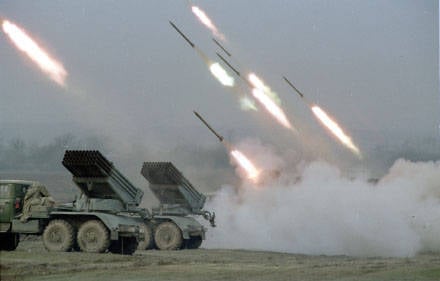 Rocket artillery being weapons volley fire, has become one of the most powerful means of mass destruction of manpower and equipment of the enemy. Multiple launch rocket launchers combine multiple charge rates, a rate of fire and a significant mass of combat salvo. The multiply charged MLRS made it possible to achieve simultaneous destruction of targets in large areas, and volley fire provided a sudden and high effect of a damaging and moral impact on the enemy.
Rocket artillery being weapons volley fire, has become one of the most powerful means of mass destruction of manpower and equipment of the enemy. Multiple launch rocket launchers combine multiple charge rates, a rate of fire and a significant mass of combat salvo. The multiply charged MLRS made it possible to achieve simultaneous destruction of targets in large areas, and volley fire provided a sudden and high effect of a damaging and moral impact on the enemy.During the Great Patriotic War in our country, a number of rocket mortars were created - BM-13 “Katyusha”, BM-8 – 36, BM-8 – 24, BM-13-H, BM-31 – 12, BM-13 CH . After the end of the Great Patriotic War, work in the Soviet Union on jet systems continued actively in the 1950s.
The worthy successor of the BM-13 “Katyusha” rocket launcher, which took its place of honor in museums, was the Soviet system of the second post-war generation — the field 122-mm divisional multiple-launch rocket system BM-21 “Grad”, intended to defeat open and hidden manpower, unarmored and light armored vehicles in areas of concentration; for the destruction and suppression of artillery and mortar batteries, command posts and other enemy targets during combat operations, for destroying command posts, communications centers, fortifications, strong points and enemy resistance centers, as well as for solving other tasks in various combat conditions, including the destruction of objects of the military-industrial infrastructure, remote installation of anti-tank and anti-personnel minefields in the combat zone at a distance of 20 km.
By the middle of the 1950-ies, the Soviet Army consisted of the BM-14 – 16 rocket launcher with sixteen 140-mm turbojet rotating projectiles, but the military did not like the range of these MLRS, limited to just 9,8 km. The Soviet Armed Forces needed a new, more powerful salvo-fire divisional system, designed to defeat manpower and unarmored vehicles in the nearest tactical depth of enemy defenses. Therefore, already in 1957, the Main Rocket and Artillery Directorate (GRAU) announces a tender for the development of a new type of rocket artillery with the possibility of destroying targets at distances up to 20 000 meters from the launch site.
In accordance with the resolution of the USSR Council of Ministers on 23 in September 1958, in Sverdlovsk, the Special Design Bureau No. 203 - the lead organization for the development of launchers for missiles - began development work on the development of the design of the 2 B5 combat vehicle. The new combat vehicle was supposed to mount a package of 30 guides for missiles. This volley fire system was originally designed for unmanaged P-115 missiles of the Swift type (Crow). However, due to the peculiarities of their design and the limitations imposed by the railway dimensions, it was possible to mount everything from 12 to 16 rails on the new combat vehicle. Therefore, the chief designer of SKB-203, A. I. Yaskin, makes a decision on the modification of the missile. To reduce its size and increase the number of guides it was planned to perform tail stabilizers folding. This work was entrusted to designer V. V. Vatolin, who had previously actively participated in the creation of the MLRS BM-14 – 16. He proposed to fit the stabilizers into the size of the projectile, not only folding them, but also curving along a cylindrical surface, which made it possible to use tubular-type starting guides, as in MLRS BM-14 – 16. A sketchy study of the combat vehicle with a new version of the rocket showed that in this case the project meets all the requirements of the TTZ and a pack of 30 guides can be mounted on the combat vehicle.
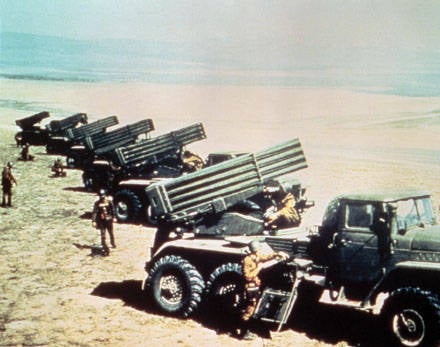 In February 1959 of the year, the State Committee for Defense Technology put forward "Tactical and technical requirements for the experimental design work" Grad "divisional field reactive system, and soon Tula NII-147 (later GNNP" Splav ") was appointed the lead contractor on this topic under the leadership of A. N. Ganicheva engaged in the creation of new artillery ammunition, including missiles. During the preliminary sketch study, the designers of the SRI-147 also found that the selected caliber 122-mm projectile with a powder engine allows you to most closely approach the performance requirements for the total number of projectiles on the launcher and achieve the maximum range of the rocket projectile.
In February 1959 of the year, the State Committee for Defense Technology put forward "Tactical and technical requirements for the experimental design work" Grad "divisional field reactive system, and soon Tula NII-147 (later GNNP" Splav ") was appointed the lead contractor on this topic under the leadership of A. N. Ganicheva engaged in the creation of new artillery ammunition, including missiles. During the preliminary sketch study, the designers of the SRI-147 also found that the selected caliber 122-mm projectile with a powder engine allows you to most closely approach the performance requirements for the total number of projectiles on the launcher and achieve the maximum range of the rocket projectile.By the summer of 1959, the designers of SKB-203 had developed four versions of the pre-sketch projects of the 2 B5 combat vehicle. All developments were carried out for two types of shells: for a projectile with drop-down stabilizers and with a hard tail.
Initially, as a combat vehicle for a new multiple rocket launcher system, options were considered based on the SU-100 P-based automatic control system with 30 rails and a YAZ-214 truck with 60 rails. Ultimately, a new three-axle all-wheel-drive truck “Ural-375”, which was just developed at the Urals Automobile Plant in Miass, was the most suitable chassis for the combat vehicle.
And several months later, in the autumn of the same year, the first tests of rocket projectiles were tested at the Pavlograd SKB-10 test site to check the strength, flight range, high-explosive and fragmentation effect of rocket projectiles, combat accuracy, equipment durability and testing of the elements of the launcher guides. For the test were presented two versions of the projectile - with a hard tail and a drop-down tail. All work on the preliminary draft design allowed us to create an essential design basis for designing a new salvo fire system. Soon these works reached a qualitatively new level.
30 May 1960 of the year, in accordance with the decision of the Council of Ministers of the USSR, the domestic defense industry was to create a new field divisional multiple launch rocket system “Grad”, designed to replace the MLRS BM-14. Designers who took part in the development work of the Grad field reactive system should have created an easy to manufacture and use complex that was not inferior to their foreign counterparts in their technical characteristics. The general management of all design work was carried out by a talented engineer — Chief Designer of the Scientific Research Institute-147, Alexander Nikitovich Ganichev, and Alexander Yaskin, Chief Designer of the SKB-203, continued to lead the development of the launcher. Now, the development of the Grad MLRS also involved a number of development companies in cooperation: the development of an unguided rocket was conducted by the research institutes-147 and related enterprises (the scientific research institutes-6 were engaged in solid-fuel charges; GSK-47 was equipped with 122-mm unmanaged reactive warheads projectile), and the creation of a mobile launcher 2 B-5 continued to work SKB-203.
Work on the creation of the new MLRS was associated with many problems. First of all, there was a question of choosing the aerodynamic configuration of a missile. In fact, work on a missile projectile was carried out on a competitive basis between the Scientific Research Institute-147 and the Scientific Research Institute-1, which proposed a modernized Strizh anti-aircraft missile. According to the results of consideration of both proposals, GRAU considered the NII-147 projectile to be the best, whose main advantage was a more sophisticated technology for manufacturing rockets shells. If NII-1 proposed to make them using traditional steel cutting from steel blanks, then NII-147 proposed to use a new high-performance technological hot-drawing method from steel sheet billet for manufacturing rockets shells, as was done in the production of artillery ammunition shells. This design had a revolutionary impact on all further development of rocket artillery systems in this caliber.
As a result of the large amount of work carried out at SRI-147, an uncontrolled 122-mm rocket M-21 OB (with a high-explosive fragmentation warhead with a two-chamber rocket engine and a stabilizer unit) was created. The rocket charge developed by the staff of the Scientific Research Institute-6 (now the State Scientific Center of the Russian Federation, Federal State Unitary Enterprise Central Scientific Research Institute of Chemistry and Mechanics) contained in each cell one single-piece powder charge of solid fuel, but of different sizes. The mass of the two charges was 20,45 kg.
Missile M-21 OF had a mixed stabilization system, stabilizing in flight as folding blades and rotating around its longitudinal axis. Although the rotation of the missile in flight after descending from the guide took place at a low speed of only a few dozen revolutions per second and did not create a sufficient gyroscopic effect, it compensated for the deviation of the engine thrust, thus excluding the most important cause of dispersion of missiles. In the 122-mm “Grad” rocket projectile, the plumage of four curved blades fixed in a folded position and secured to the cylindrical surface of the tail section, folded in the folded position, was used for the first time. As a result, the NII-147 designers managed to create a fairly compact missile that fits well with the tubular launch guide. The initial rotation was given due to the movement of the projectile in the guide, having a spiral guide U-shaped groove.
Rotation of the projectile in flight along the trajectory was supported by the blades of a drop-down stabilizer, fixed at an angle 1 degree to the longitudinal axis of the projectile. This stabilization system was close to optimal. Thus, the design team under the leadership of A. N. Ganichev succeeded, with a large lengthening of the feathered rocket in transverse dimensions, combined with a powerful engine, not to go beyond its diameter, which was previously achieved only in the design of turbojets, and time to reach a given range of shooting - 20 kilometers. In addition, thanks to this design, it became possible to increase the number of guides of a combat vehicle, increasing the power of the volley, and reduce the number of combat vehicles required to hit a target.
The high-explosive effect of the new missile was similar to that of 152-mm artillery high-explosive fragmentation shells, while the fragments formed much more.
As a chassis for the 2 B5 combat vehicle, the truck chassis of the Ural-375 D cross-country truck was finally selected. This three-axle all-wheel drive truck was equipped with a 180-strong carburetor gasoline engine. At the end of the 1960 of the year, one of the first prototypes of the Ural-203 chassis was delivered to SKB-375, still with a canvas top of the cockpit, and in January 1961 saw the light of the first MLRS model design. To simplify the design of the launcher, the guides received a tubular shape, and in the original version the nominal position of the package of guides for firing was chosen across the longitudinal axis of the car. However, the first test launches of missiles revealed the complete unsuitability of such a scheme, not only because of the strong rocking of the platform during firing, but also to reduce the accuracy of the firing itself. Therefore, along with the rotation of the guide designers had to significantly strengthen the suspension and take measures to stabilize the body. Now shooting (both single projectiles and a volley) became possible not only strictly along the longitudinal axis of the car, but also at an acute angle to it.
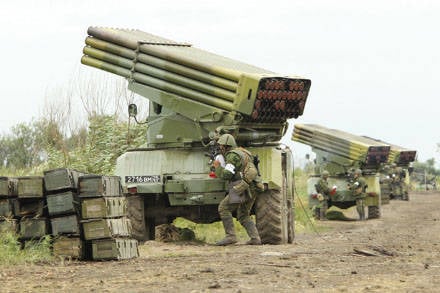 Two experimental units BM-21 "Grad" passed factory tests at the end of the year 1961. From 1 March to 1 in May 1962, at the Rzhev artillery range in the Leningrad Military District, state ground-force tests of the Grad divisional field rocket system took place. They planned to make a shot 663 rocket projectiles and make a run combat vehicles at a distance 10 000 km. However, the experienced 2 B5 machine passed only 3380 km, after which it had a chassis spar failure. After installing the artillery unit on the new chassis, the tests were continued, but the breakdowns continued to pursue this system. The deflections of the rear and middle axles again came to light, the drive shaft was bending from a collision on the balance shaft axis, etc. As a result, the specialists of the Ural Automobile Plant had to deal with a radical improvement of their chassis. Work was carried out to improve the rear axles and use for the manufacture of spars doped steel frame. It took about a year to eliminate the identified shortcomings and to refine the complex more thoroughly.
Two experimental units BM-21 "Grad" passed factory tests at the end of the year 1961. From 1 March to 1 in May 1962, at the Rzhev artillery range in the Leningrad Military District, state ground-force tests of the Grad divisional field rocket system took place. They planned to make a shot 663 rocket projectiles and make a run combat vehicles at a distance 10 000 km. However, the experienced 2 B5 machine passed only 3380 km, after which it had a chassis spar failure. After installing the artillery unit on the new chassis, the tests were continued, but the breakdowns continued to pursue this system. The deflections of the rear and middle axles again came to light, the drive shaft was bending from a collision on the balance shaft axis, etc. As a result, the specialists of the Ural Automobile Plant had to deal with a radical improvement of their chassis. Work was carried out to improve the rear axles and use for the manufacture of spars doped steel frame. It took about a year to eliminate the identified shortcomings and to refine the complex more thoroughly.On March 28, 1963, the Grad multiple launch rocket system entered service with individual rocket artillery battalions of motorized rifle and tank divisions of the Soviet army. With the adoption of the Grad system in the artillery regiments of all divisions, a separate MLRS division was introduced, as a rule, consisting of 18 BM-21 combat vehicles.
The multiply-charged nature of these jet systems, which have small-sized and simple launchers, determined the possibility of simultaneous destruction of targets over large areas, and volley fire ensured a sudden and high effect on the enemy. The BM-21 “Grad” combat vehicles, being highly mobile, were able to open fire within a few minutes after arriving at the position and leave it immediately after leaving the return fire.
A number of structural elements and fastenings of the BM-21 artillery unit were subsequently unified for the artillery units of the 9 П125 MLRS Grad-V and the 9 ПХNUMX MLRS "Uragan" combat vehicle.
The serial production of the BM-21 “Grad” multiple launch rocket system was launched in 1964 at the Perm Machine-Building Plant named after A. VI Lenin, and 122-mm unguided rockets M-21 OB - at the plant number 176 in Tula.
Already 7 November 1964 of the year at the military parade on Red Square in Moscow were the first two serial combat vehicles "Grad" BM-21, assembled in Perm. However, they were still incomplete - they had no electric artillery units. And only with 1965, the Grad system began to arrive in the army in massive quantities. By this time, a serial production of Ural-375 D trucks for the BM-21 combat vehicle was launched at the automobile plant in Miass. Over time, the BM-21 combat vehicle was significantly improved, and the range of missiles to it significantly expanded. The production of the 9 К51 “Grad” volley fire system continued by the Soviet defense industry on a large scale up to the 1988 year. During this time, only 6536 combat vehicles were delivered to the Soviet army, and at least 646 vehicles were made for export. By the beginning of 1994, the 4500 MLRS BM-21 was in service with the Armed Forces of the Russian Federation, and in the 1995 year, that is, several years after the completion of mass production, even more 2000 BM-21 combat vehicles were used than 60 countries of the world. Over the same time, more than 3 000000 different 122-mm unguided rockets were manufactured for the Grad MLRS. And now the MLRS BM-21 continues to be the most massive combat vehicle of this class.
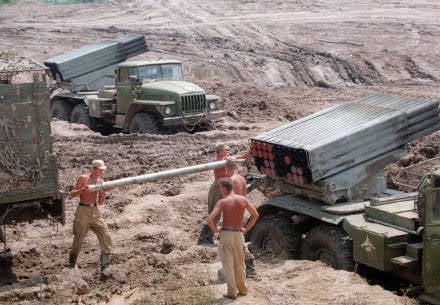 The combat vehicle BM-21 "Grad" allows firing from the cockpit without preparing a firing position, which provides the ability to quickly open fire. MLRS BM-21 has high dynamic qualities and maneuverability, which allows it to be effectively used in conjunction with armored vehicles on the march and at the forefront during combat operations. The launcher, having high maneuverability, can easily overcome difficult off-road conditions, steep descents and ascents, and when driving on paved roads it can reach speeds up to 75 km / h. In addition, the BM-21 combat vehicle is also capable of overcoming water barriers without prior training with a ford depth - up to the 1,5 meter. Thanks to this, rocket artillery units can, depending on the situation, be moved from one position to another and suddenly hit the enemy. The salvo of one BM-21 combat vehicle provides manpower hit areas - approximately 1000 square meters, and non-armored vehicles - 840 square meters.
The combat vehicle BM-21 "Grad" allows firing from the cockpit without preparing a firing position, which provides the ability to quickly open fire. MLRS BM-21 has high dynamic qualities and maneuverability, which allows it to be effectively used in conjunction with armored vehicles on the march and at the forefront during combat operations. The launcher, having high maneuverability, can easily overcome difficult off-road conditions, steep descents and ascents, and when driving on paved roads it can reach speeds up to 75 km / h. In addition, the BM-21 combat vehicle is also capable of overcoming water barriers without prior training with a ford depth - up to the 1,5 meter. Thanks to this, rocket artillery units can, depending on the situation, be moved from one position to another and suddenly hit the enemy. The salvo of one BM-21 combat vehicle provides manpower hit areas - approximately 1000 square meters, and non-armored vehicles - 840 square meters.The calculation of the BM-21 combat vehicle consists of a 6 man and includes: the commander; 1 of the calculation number - the gunner; 2 number - fuse installer; 3 number - loader (radiotelephone); 4 number - the driver of the transport vehicle - loader; 5 number - the driver of the combat vehicle - loader.
The duration of a full salvo is 20 seconds. Due to the sequential descent of the projectiles from the guides, the rocking of the launcher during firing is reduced to a minimum. The transfer time of the BM-21 “Grad” combat vehicle from the traveling position to the combat position does not exceed 3,5 minutes.
Manual reloading. Loading each tube in the package of BM-21 guides from the transport vehicle is performed by calculating at least 2 people, and loading from the ground - by calculating at least 3 people.
High dynamic qualities and maneuverability make it possible to effectively use the Grad complex in conjunction with armored vehicles both on the march and at the front positions during combat operations. The 9 К51 “Grad” multiple launch rocket system is not only one of the most effective multiple launch rocket systems, but also itself has become the base for a number of other domestic systems created in the interests of various combat arms.
The BM-21 system is constantly being upgraded - today there are several modifications of combat units and missiles to them.
The BM-21 Grad-V (9 K54) is a field airborne rocket launcher system for airborne troops with 12 guides mounted on the chassis of a GAZ-66 B. Its design took into account the specific requirements for combat airborne troops technique: increased reliability, compactness and low weight. Due to the use of a lighter chassis and reducing the number of guides from 40 to 12, the mass of this combat vehicle was reduced more than twice - to 6 tons in combat position, which its air transportability was achieved on the most massive military transport aircraft of the USSR Air Force - An -12, and further on IL-76.
Subsequently, on the basis of the BTR-D armored personnel carrier for the airborne troops, another airborne system of the Grad-VD multiple rocket launcher was developed, which was a tracked version of the Grad-V system. It included the BM-21 VD combat vehicle with a mounted package of 12 guides and a transport-loading vehicle.
BM-21 "Grad-1" (9 K55) - 36-barrel rocket launcher system. The MLRS Grad-1 was adopted in 1976 by the artillery units of the motorized rifle regiments of the Soviet army and the naval infantry regiments of the Navy and was intended to destroy enemy forces and military equipment in areas of concentration, artillery and mortar batteries, command posts and other targets directly on front edge of the front. On the basis of the smaller width of the front and the depth of the regiment’s combat operations, compared with the division, it was considered possible to reduce the maximum range of this system to 15 km.
The Grad-9 138 P1 combat vehicle, assumed to be more mass compared to the original version, was developed on the basis of the cheaper and more massive chassis of the ZIL-131 high-transit truck and the artillery part of the Grad rocket system. Unlike the MLRS BM-21, the 9 P138 combat vehicle guide package did not consist of 40, but 36 tracks arranged in four rows (the two upper rows had 10 tracks, and the two lower ones had 8). The new design of the package of 36 guides has reduced the weight of the Grad-1 combat vehicle by almost a quarter (compared to the BM-21) - to 10,425 tons. The area of destruction by a volley of rockets was: for manpower - 2,06 ha, for technology - 3,6 ha.
BM-21 “Grad-1” (9 К55 – 1). To arm artillery regiments of tank divisions, another, tracked, variant of the Grad-1 rocket launcher system based on the 122-2 1 36 XNUMX self-propelled howitzer chassis with a package of XNUMX guides was created.
Grad-M (A-215) is a naval multiple launch rocket system, adopted in 1978 for the arsenal of large landing ships of the USSR Navy. Grad-M included an MS-73 launcher with 40 guides. The A-215 Grad-M complex, first installed on a large landing ship BDK-104, was tested at the Baltic navy in the spring of 1972. From the ML-BMO BM-21, the ship’s launcher was distinguished by the ability to quickly (within two minutes) reload and high speeds of vertical and horizontal guidance - 26 ° per second and 29 ° per second (respectively), which allowed in cooperation with the firing control system providing it “Thunderstorm-1171” to stabilize the launcher and conduct effective firing with an interval between shots of 0,8 seconds with sea waves up to 6 points.
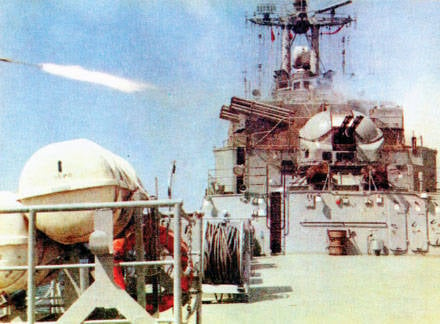 BM-21 PD "Damba" - coastal complex. The self-propelled 40-barreled rocket launcher system is designed to destroy surface and underwater targets, as well as to protect naval bases from the actions of small submarines and to fight against combat swimmers-saboteurs. The onshore complex “Dam”, created in the Tula State National Production Enterprise “Splav”, was adopted by the Navy in 1980. In a modernized version of the 40-barrel launcher DP-62 mounted on the chassis of the truck "Ural-4320". Shooting from the BM-21 PD system could be carried out as a single launch of missiles, and partial or full salvos. Unlike the standard BM-21, the Damba complex was equipped with means for receiving, targeting, and entering installations into missile warheads. The Damba complex worked in conjunction with a hydroacoustic station included in the coastal defense system, or in the autonomous mode. The projectile warhead was cylindrical to eliminate the ricochet from the water surface. The warhead was undermined similarly to a conventional depth bomb at a given depth.
BM-21 PD "Damba" - coastal complex. The self-propelled 40-barreled rocket launcher system is designed to destroy surface and underwater targets, as well as to protect naval bases from the actions of small submarines and to fight against combat swimmers-saboteurs. The onshore complex “Dam”, created in the Tula State National Production Enterprise “Splav”, was adopted by the Navy in 1980. In a modernized version of the 40-barrel launcher DP-62 mounted on the chassis of the truck "Ural-4320". Shooting from the BM-21 PD system could be carried out as a single launch of missiles, and partial or full salvos. Unlike the standard BM-21, the Damba complex was equipped with means for receiving, targeting, and entering installations into missile warheads. The Damba complex worked in conjunction with a hydroacoustic station included in the coastal defense system, or in the autonomous mode. The projectile warhead was cylindrical to eliminate the ricochet from the water surface. The warhead was undermined similarly to a conventional depth bomb at a given depth.Grad-P (9 P132) - 122-mm portable rocket launcher system. At the request of the Government of the Democratic Republic of Vietnam, in order to conduct special operations in South Vietnam in 1965, the designers of the Scientific Research Institute-147 together with their colleagues from the Tula Central Design and Research Bureau of sport and hunting weapons created the 9 PNNUMX portable single-shot launcher. It was part of the “Grad-P” complex (“Partizan”) and was a tubular guide launcher with a length of 132 mm, mounted on a tripod folding machine with vertical and horizontal guidance mechanisms. The installation was completed with sights: an artillery compass and a PBO-2500 sight. The total mass of the installation did not exceed 2 kg. She was easily understood and transferred by calculating 55 people in two 5 and 25 kg packages. The installation was transferred from the traveling position to the combat position - in 28 minutes. For fire control, a sealed remote control connected to the launcher with an 2,5 meter-long electric cable was used. Especially for the Grad-P complex, the 20-mm 147 М122 М (“Kid”) 9 unguided missile with a total weight of 22 kg, also adapted to be carried in two packs, was developed at SRI-46. The maximum launch range did not exceed 10 800 meters. The serial production of the 122-mm portable Grad-P rocket launcher (9 ПХNUMX) was organized at the Kovrovsky Mechanical Plant in the 132 year. In 1966 - the beginning of 1966-s several hundreds of Grad-P installations were supplied to Vietnam from the USSR. The Grad-P installation was not accepted for arming the Soviet army, but was only made for export.
BM-21 – 1 Grad. In 1986, the Perm Machine-Building Plant. V.I. Lenin completed the development work “Creating a BM-21 – 1 combat vehicle of the 122-mm MLRS Grad complex”. The designers conducted a radical modernization of the BM-40 “Grad” 21-barrel system of volley fire. As a base for a combat vehicle, a modified chassis of a diesel truck Ural-4320 was used. The combat vehicle BM-21 – 1 had a new artillery unit consisting of two 20-barrel packages of guides mounted in disposable transport and launch containers (TPK) made of polymeric composite materials. They were installed on a combat vehicle with the help of a special additional transition frame. In this system, the accelerated recharging of the system was not carried out by separately installing each rocket into the guide tube manually, but immediately with the help of lifting equipment by means of total replacement of containers, the weight of which in the charged state was 1770 kg. The loading time was reduced to 5 minutes, but the total mass of the installation increased to 14 tons. In addition, thanks to the accumulated combat experience of the war in Afghanistan in the new complex, unlike the BM-21, the BM-21 – 1 guide tube packages received a heat shield that protects the pipes from direct sunlight. From the cockpit of the BM-21 – 1 combat vehicle, it was now possible to fire immediately, without preparing a firing position, which made it possible to quickly open fire. However, at the end of the 1980-ies, during the times of perestroika and mass disarmament of the Soviet Armed Forces, this version of the MLRS was not put into mass production, and its phased modernization continues to this day. While maintaining the previous one package of guides, an upgraded fire control system with a navigation system and an onboard computer was mounted on it, and new missiles were used to increase the firing range to 35 km.
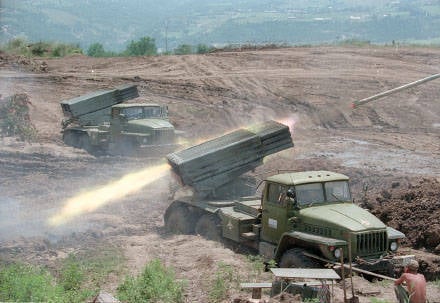 "Prima" (9 K59) is a deep modernization of the multi-purpose 122-mm Grad multiple launch rocket reactive system with increased firepower on the chassis of the Ural-4320 truck. The Prima complex included the 9 А51 combat vehicle with the 50-barrel rocket launcher system and the 9 Т232 М transport-charging machine based on the Ural-4320 truck with a mechanized recharge process that took no more than 10 minutes. The 9 К59 “Prima” complex was adopted by the Soviet Army in 1989, however, due to the Soviet leadership during the years of the restructuring of the arms limitation policy, this system did not go into mass production.
"Prima" (9 K59) is a deep modernization of the multi-purpose 122-mm Grad multiple launch rocket reactive system with increased firepower on the chassis of the Ural-4320 truck. The Prima complex included the 9 А51 combat vehicle with the 50-barrel rocket launcher system and the 9 Т232 М transport-charging machine based on the Ural-4320 truck with a mechanized recharge process that took no more than 10 minutes. The 9 К59 “Prima” complex was adopted by the Soviet Army in 1989, however, due to the Soviet leadership during the years of the restructuring of the arms limitation policy, this system did not go into mass production.The most noticeable external difference between the "Prima" and the "Grad" is a longer box-shaped casing, in which the package of tubular guides of the launcher is mounted. The strength of the combat crew has been reduced to 3 man vs 7 in the Grad system of BM-21. A feature of the Prima system is that, along with the use of standard missiles from the BM-21 Grad, it was the first to use a new more effective unguided 122-mm high-explosive fragmentation projectile 9 M53 F with a parachute stabilization system, as well as smoke 9 M43 projectile. The firing range was also 21 km, but the impact area was 7 – 8 times larger than that of the BM-21 combat vehicle. The duration of one volley was 30 seconds, which was 4 – 5 times less than that of the BM-21, with the same range and accuracy of shooting.
2 B17 – 1 Tornado-G (9 K51 M). In 1998, the design bureau of OJSC Motovilikhinskie Zavody completed work on creating a modernized version of Grada, an automated combat vehicle based on BM-21 – 1 with new 122-mm unguided missiles with a maximum range increased to 40 km. The upgraded sample of the MLRS 9 K51 M "Tornado-G" received the designation "2 B17 – 1". The 2 БХNUMX – 17 Tornado-G combat vehicle is equipped with an automated guidance and fire control system, satellite navigation system, preparation and launch equipment based on the Baguette 1 computer and other optional equipment. This whole complex provides information and technical interface with the control machine; automated high-speed reception (transmission) of information and protection from unauthorized access, visual display of information on a computer screen and its storage; Autonomous topographic location (determination of initial coordinates, determination of current coordinates when moving) using satellite navigation equipment with display of location and route of movement on an electronic map of the area with display on a computer screen; initial orientation of the package of guides and automated guidance of the package of guides to the target without leaving the calculation from the cockpit and using sighting devices; automated remote entry of data into a rocket fuse; launch unguided rockets without leaving the calculation of the cabin.
All this has dramatically improved the effectiveness of hitting targets. And soon another option appeared - an automated combat vehicle 2 B17 M, equipped with the protection of the information transfer device. Recently there was another modernization of the Grad MLRS. As a result of these works, a new 2 B26 combat vehicle was created on the modified chassis of the KAMAZ-5350 truck.
Illumination (9 K510) is a portable rocket launcher system for firing 122-mm unguided rocket projectiles. The Illumination complex was developed by designers of the Tula NPO Splav and related enterprises. It is designed to provide light for combat operations, for units guarding the border at night, important state facilities, as well as in case of accidents and natural disasters. The Illumination complex consisted of a single-barrel launcher with a mass of 35 kg, an unguided 9 MXNXX missile and a launch pad. The 42 K9 complex is serviced by a two-person settlement.
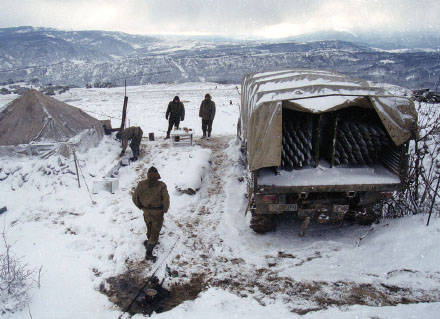 "Beaver" (9 ФХNUMX) - target complex. In 689, the target complex “Beaver” was adopted by the Russian army. It is intended for staffing training centers and training grounds for conducting training and test shooting using portable anti-aircraft missile systems and anti-aircraft missile systems at the regimental and divisional level. Air target simulators provide a simulation of the flight of air attack assets both in terms of speed and trajectory parameters, and on the characteristics of electromagnetic radiation, including low-profile aircraft at extremely low altitudes; cruise missiles; damaging elements of high-precision weapons and remotely piloted aircraft. The “Beaver” complex includes a single-barrel launcher with a mass of 1997 kg, uncontrollable rockets - simulators of aerial targets and a remote launch console. The target complex "Beaver" is served by the calculation of two people. Launching projectiles - simulators of air targets can be made at a distance of up to 24,5 km. All simulator projectiles contain a tracer, which provides visual observation of them on the flight path.
"Beaver" (9 ФХNUMX) - target complex. In 689, the target complex “Beaver” was adopted by the Russian army. It is intended for staffing training centers and training grounds for conducting training and test shooting using portable anti-aircraft missile systems and anti-aircraft missile systems at the regimental and divisional level. Air target simulators provide a simulation of the flight of air attack assets both in terms of speed and trajectory parameters, and on the characteristics of electromagnetic radiation, including low-profile aircraft at extremely low altitudes; cruise missiles; damaging elements of high-precision weapons and remotely piloted aircraft. The “Beaver” complex includes a single-barrel launcher with a mass of 1997 kg, uncontrollable rockets - simulators of aerial targets and a remote launch console. The target complex "Beaver" is served by the calculation of two people. Launching projectiles - simulators of air targets can be made at a distance of up to 24,5 km. All simulator projectiles contain a tracer, which provides visual observation of them on the flight path.Along with Russia, work on the Grazo MLRS is currently ongoing in the former Soviet republics - the CIS countries.
Thus, in Belarus at the beginning of 2000-s, the Grad-1 A (BelGrad) multiple rocket launcher system was launched, which is a Belarusian modification of the Grad system with a BM-21 combat unit mounted on the chassis of a MAZ truck 6317 – 05.
Ukrainian designers have created their modernization of the MLRS BM-21 "Grad" - BM-21 At "Grad-M". Ukrainian RZSO “Grad-M” is an artillery unit BM-6322 mounted on the KrAZ-6322 or KrAZ-120 – 82 – 21 automobile chassis. The new chassis made it possible to provide the combat system with doubled ammunition.
The development of 122-mm unguided rockets for the BM-21 “Grad” system was carried out by the Scientific Research Institute-147, which since 1966 has been called the Tula State Scientific Research Institute of Precision Engineering (now called “GUP GNPP“ Splav ”).
The main types of ammunition for the BM-21 “Grad” salvo fire are rocket projectiles with high-explosive fragmentation and detachable high-explosive fragmentation warheads and a parachute stabilization system, with an incendiary, smoke-smoking and agitation head units, anti-personnel parachute systems for launching anti-personnel units and anti-personnel gear and anti-personnel weapons. minefields, radio jamming, lighting rockets.
In addition, missiles with a cluster head are used in equipment with two self-targeting (adjustable) combat elements and a dual-band infrared guidance system. They intend to defeat armored and other self-propelled vehicles (tanks, infantry fighting vehicles, armored personnel carriers, SAU). Also used missile with a cassette warhead in equipment with cumulative fragmentation combat elements. It was intended to destroy lightly armored vehicles (infantry fighting vehicles, armored personnel carriers, self-propelled artillery systems), manpower, airplanes and helicopters in parking lots.
Especially for the BM-21 "Grad" was created and a missile with a high-explosive fragmentation warhead of increased power. It was intended to destroy open and sheltered manpower, unarmored vehicles and armored personnel carriers in areas of concentration, artillery and mortar batteries, command posts and other targets. Due to the design features of the projectile, the effectiveness of damage has increased on average two times compared with the combat part of a regular projectile.
In the process of creating the MLRS BM-21 "Grad" in the Soviet Union, a number of experimental design and research work was carried out on the creation of various-purpose rockets for this system. As a result, in 1968, Soviet missiles were adopted and mastered in mass production with special filling rocket projectiles with chemical warheads.
Currently, the MLRS BM-21 "Grad" in various versions continues to be in service with armies in more than 60 countries of the world. A wide variety of copies and variants of the BM-21 “Grad” multiple launch rocket launchers were produced in Egypt, India, Iran, Iraq, the People's Republic of China, the DPRK, Pakistan, Poland, Romania, Czechoslovakia and the Republic of South Africa. Many of these countries have mastered the production of unguided rockets to them.
For fifty years of use, the BM-21 “Grad” system has been repeatedly and quite successfully used in hostilities in Europe, Asia, Africa and Latin America.
The military baptism of BM-21 "Grad" received 15 March 1969 of the year during the military conflict between the USSR and the PRC on the Ussuri River on Damansky Island. On this day, units and subunits of the 135 Motorized Rifle Division deployed along the Ussuri River took part in the hostilities. In 17.00, in a critical situation, by order of the commander of the Far Eastern Military District, Colonel-General O. Losik, a separate division of the then secret multiple launch rocket systems (MLRS) Grad opened fire. After a massive use of the Grad installations that fired high-explosive rocket unguided projectiles, the island was completely ruined. Missiles destroyed most of the material and technical resources of the Chinese group, including reinforcements, mortars, shells, and Chinese border trespassers were completely destroyed. The volleys of the “Grad” installations brought the logical end to the military conflict on this island.
In 1970-2000-s, the “Grad” complex was used in almost all local military conflicts in the world, in various climatic conditions, including the most extreme ones.
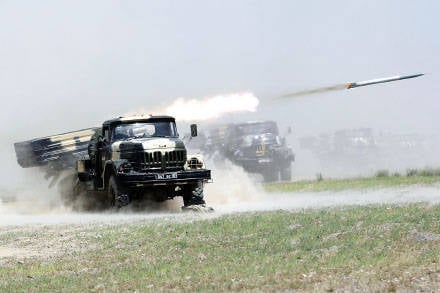 The BM-21 “Grad” multiple rocket launchers were widely used by Soviet units from the limited contingent of Soviet troops in Afghanistan during combat operations in 1979 – 1989. In Afghanistan, the BM-21 Grad installations gained deserved prestige with sudden and accurate fire. Possessing considerable destructive power in combination with a large area of destruction, this system was used to destroy an openly located enemy on the crests of heights, mountain plateaus and in the valleys. In some cases, the MLRS BM-21 was used for remote mining of the terrain, which made it difficult, and in part, precluded the exit of the enemy from the "blocked" sections of the terrain. A wide range of ammunition of various directions allowed the use of the MLRS at the maximum range of 20 – 30 km, including for avalanches, fires and stone debris in the enemy’s territory. The terrain conditions in Afghanistan often required a special approach to the selection of the terrain to accommodate the MLRS firing positions. If on the flat terrain there were practically no problems in this area, the mountains were badly affected by the lack of flat areas necessary for the deployment of BM-21 combat vehicles. This led to the fact that firing platoons of rocket artillery batteries were often placed at reduced distances (intervals). In some cases, only one combat vehicle could be placed in the firing position. Having made a volley, she quickly left for reloading, and her place was occupied by another “Grad”. Thus, the shooting was carried out until the fulfillment of the fire mission or the achievement of the required degree of destruction of the target. Often, due to the specific conditions of combat operations in the mountains, multiple rocket launchers were forced to fire at short distances (mostly 5 – 6 km). The low height of the trajectory at these ranges did not always allow firing through the crest of the shelter. The use of large brake rings allowed to increase the height of the trajectory by 60 percent. Moreover, if in Afghanistan firing from the MLRS BM-21 was most often carried out on squares, including settlements (at the same time, the Soviet artillerymen for the first time began to use shooting at low elevation angles and direct fire), for example, Palestinian partisans in Lebanon used tactics roaming rocket launchers. Only one BM-21 was applied to the Israeli troops, which then immediately changed position.
The BM-21 “Grad” multiple rocket launchers were widely used by Soviet units from the limited contingent of Soviet troops in Afghanistan during combat operations in 1979 – 1989. In Afghanistan, the BM-21 Grad installations gained deserved prestige with sudden and accurate fire. Possessing considerable destructive power in combination with a large area of destruction, this system was used to destroy an openly located enemy on the crests of heights, mountain plateaus and in the valleys. In some cases, the MLRS BM-21 was used for remote mining of the terrain, which made it difficult, and in part, precluded the exit of the enemy from the "blocked" sections of the terrain. A wide range of ammunition of various directions allowed the use of the MLRS at the maximum range of 20 – 30 km, including for avalanches, fires and stone debris in the enemy’s territory. The terrain conditions in Afghanistan often required a special approach to the selection of the terrain to accommodate the MLRS firing positions. If on the flat terrain there were practically no problems in this area, the mountains were badly affected by the lack of flat areas necessary for the deployment of BM-21 combat vehicles. This led to the fact that firing platoons of rocket artillery batteries were often placed at reduced distances (intervals). In some cases, only one combat vehicle could be placed in the firing position. Having made a volley, she quickly left for reloading, and her place was occupied by another “Grad”. Thus, the shooting was carried out until the fulfillment of the fire mission or the achievement of the required degree of destruction of the target. Often, due to the specific conditions of combat operations in the mountains, multiple rocket launchers were forced to fire at short distances (mostly 5 – 6 km). The low height of the trajectory at these ranges did not always allow firing through the crest of the shelter. The use of large brake rings allowed to increase the height of the trajectory by 60 percent. Moreover, if in Afghanistan firing from the MLRS BM-21 was most often carried out on squares, including settlements (at the same time, the Soviet artillerymen for the first time began to use shooting at low elevation angles and direct fire), for example, Palestinian partisans in Lebanon used tactics roaming rocket launchers. Only one BM-21 was applied to the Israeli troops, which then immediately changed position.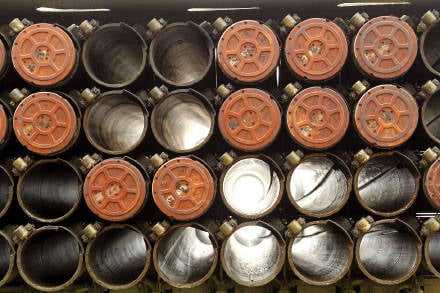 BM-21 “Grad” rocket launchers were also used in large quantities in combat operations during armed conflicts in Africa (in Angola, Algeria, Mozambique, Libya, Somalia), in Asia (in Vietnam, in Iran, Iraq, Kampuchea, Lebanon, Palestine, Syria), in Latin America (in Nicaragua), as well as during the recent conflicts on the territory of the former USSR (in Armenia, Azerbaijan, Transnistria). “Grady” was also successfully used in Russia itself - during the first and second Chechen campaigns, as well as for the fight against Georgian troops in South Ossetia.
BM-21 “Grad” rocket launchers were also used in large quantities in combat operations during armed conflicts in Africa (in Angola, Algeria, Mozambique, Libya, Somalia), in Asia (in Vietnam, in Iran, Iraq, Kampuchea, Lebanon, Palestine, Syria), in Latin America (in Nicaragua), as well as during the recent conflicts on the territory of the former USSR (in Armenia, Azerbaijan, Transnistria). “Grady” was also successfully used in Russia itself - during the first and second Chechen campaigns, as well as for the fight against Georgian troops in South Ossetia.
Information